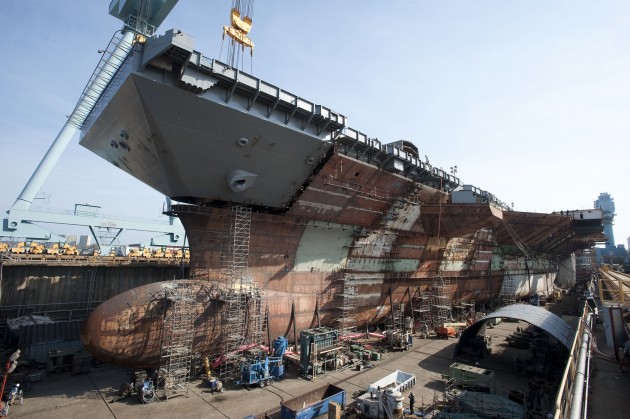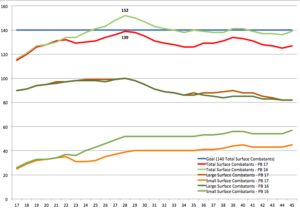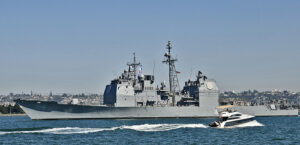355-Ship Fleet Costs $5B Extra Per Year: CRS
Posted on

The $13 billion supercarrier USS Ford under construction in Newport News, Va.
WASHINGTON: Building the Navy’s 355-ship fleet will be even harder than we thought, according to a new study from the Congressional Research Service. Veteran Navy expert Ronald O’Rourke estimates that, even if US shipyards work 50 percent faster than today, we wouldn’t have enough aircraft carriers until roughly 2030 — 14 years from now — and enough attack submarines until late in that decade. He puts the added cost at $4.6 to $5.1 billion a year in shipbuilding funds alone — $138 to $153 billion over the Navy’s 30-year shipbuilding plan. That’s not counting the costs to operate, maintain, and crew the ships. To do that, O’Rourke estimates you’d need 15,000 additional sailors and aviation personnel.
Rl 32665 by BreakingDefense on Scribd
O’Rourke bases his estimates on an insight I’ve not seen elsewhere. To sustain a 355-ship fleet for any length of time, you need more than 355 ships. Why? Because ships get worn out and retire, just like people or cars. The Navy’s good at upgrading obsolete vessels, but at some point — about 25 years for a lightweight Littoral Combat Ship, 35 years for a destroyer, 50 years for a nuclear-powered aircraft carrier — it’s better to buy a replacement rather than to keep pouring money into an aging, beat-up hull. That changes the math.

Large, Small, and total surface combatants in current (PB 17) and last year’s (PB 16) 30-year shipbuilding plan.
The Navy’s new goal of 355 ships is 47 higher than its old one of 308. (It’s 81 over the Navy’s size today, 274). But if you only add 47 ships to the 30-year shipbuilding plan, you’ll reach 355 only to drop back down in weeks when the oldest of your 355 retires. Soon after that you’ll hit 353, then 352, and so on down.
So, to sustain a 355-ship fleet, O’Rourke calculates you need to add not 47 ships, but 57 to 67 to the 30-year plan. Instead of adding one aircraft carrier to the plan — the difference between a 308-ship fleet with 11 carriers and a 355-ship fleet with 12 — you need two, building one new carrier every three years instead of the current rate of one every five (or worse). Instead of 18 additional attack submarines, you need 19, building three a year instead of two. Instead of 16 cruisers and destroyers, add 23. Instead of keeping the same number of Littoral Combat Ships — with their light and relatively short-lived hulls — add eight.
There’s more uncertainty in O’Rourke’s estimates of other classes, and he emphasizes all these figures would change if the Navy decided to keep some ships longer than planned or bring retired vessels back into service. Either move, however, would require additional expense to keep or restore the aging ship to working order. There’s also the risk that some unexpected component will fail after 30-odd years of constant battering at sea, requiring unplanned-for repairs or even taking a ship out of service.

USS Antietam in happier times.
Even human error plays a part. After the cruiser USS Antietam ran aground last week off Japan and wrecked its propellers — and possibly other components — the ship must now spend an unexpected chunk of its service life in repairs. Another cruiser, USS Port Royal, was sidelined for four years after a similar but more severe grounding off Hawaii. Indeed, the Navy wanted to write off Port Royal altogether rather than pay for repairs. If nothing else, O’Rourke’s analysis should bring new perspective to the debate over the Navy’s plan, repeatedly rejected by Congress, to temporarily mothball 11 aging cruisers.
Of course, the cruiser proposal was made under the Obama Administration. So was the global supply-and-demand analysis for different types of ships that underlies the Navy’s 355-ship Force Structure Assessment. One of Trump’s most emphatic and specific promises as a candidate was to build a 350-ship fleet — but he’s also hinted at curtailing US commitments to allies, which would drive planners towards a smaller force. Any numbers the Navy publishes this year, and any calculations based on them, may well change when (and if) the new administration hits its stride. But the underlying challenges of a big buildup will remain.
Subscribe to our newsletter
Promotions, new products and sales. Directly to your inbox.
